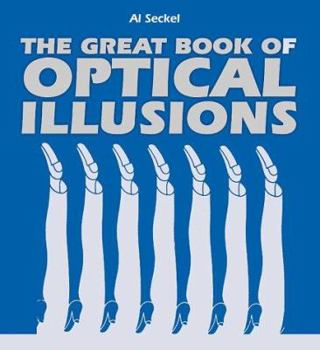The Great Book of Optical Illusions
It is said that "seeing is believing." But what if the picture you see is hard to believe? Maybe it appears to be something else entirely. In The Great Book of Optical Illusions , Al Seckel brings... This description may be from another edition of this product.
Format:Paperback
Language:English
ISBN:1552976505
ISBN13:9781552976500
Release Date:July 2005
Publisher:Firefly Books
Length:304 Pages
Weight:0.15 lbs.
Dimensions:0.7" x 9.1" x 10.0"
Customer Reviews
3 ratings
Great for kids, too...
Published by Thriftbooks.com User , 20 years ago
This book has hundreds of drawings and photographs that trick the eye in one way or another (color, perspective, hidden pictures, illusions of movement, etc). After every 20 pages or so there is a page that has a one or two sentence blurb giving background information or commentary on each illusion.My kids (ages 5 and 7) love looking through this book, and it's a great mental exercise for them, pondering how the effects are achieved and discovering what exactly the illusion is that's presented on each page. Note however, that some of the illusions are too cerebral for kids this age, or require too much patience to see.I would have liked the book even more if it had a section that discussed the concept of illusion and how the biology of eyesight and psychology plays it's part.Overall, an excellent book!
Most impressive
Published by Thriftbooks.com User , 20 years ago
We see with our brains, something that is non-intuitive and not appreciated by most of us. We think we "see" something with our eyes. The ambient light bounces off of an object and into our eyes and is embedded there, and like a camera we "see." At any rate, that was my commonsense explanation of sight for the first few decades of my life. Today I would say that our brain uses information from the light it gathers to interpret the world around us using its experience in seeing things in the past and using clues such as shadow and perspective to resolve objects. I would point out that we are actually aware of only a small faction of what there is to see at any given time. In addition to the "blind spot" in our vision field being filled in by our brains, much of the rest of our field of vision is constructed and reconstructed by our brains continually giving us the illusion of continuous sight. Unless there is movement or some other kind of change, we continue to experience the same reconstruction, like a screen being refreshed. If we focus on something in the field that previously was in our periphery, our brain reconstructs that something based on this new, more direct information. Proof of this somewhat bizarre and perhaps unsettling truth that we construct the world in our brains comes from experiments in perception by scientists, but can also be revealed though the work of artists. What Al Seckel, who teaches at Cal Tech, has done here is collect almost three hundred optical illusions done by artists, some familiar, but many not so familiar, "so that the reader has a much greater chance of being surprised." Variations on some of Escher's themes including his impossible staircases are included. There are impossible triangles and impossible cubes, some constructed from objects using mirrors. There are drawings like the famous young girl/old hag that pop in and out definition as our eyes fatigue from one to the other--included here on p. 87 as "My Wife and Mother-in Law." There are pictures in which a person is smiling and then when turned upside down, the picture becomes someone else frowning. Other forms include lines and shadings that appear to move, black and white designs that trick the eye into seeing color, a photomosaic of a tiger made entirely of animal pictures and a dog similarly constructed. Famous artists include Rene Magritte, Escher, Salvador Dali, and others. There are photos of three-dimensional illusions including "Haemaker's Impossible Twisted Rectangle" which must be seen from a particular angle for the illusion to manifest itself. There are grid illusions in which dots appear at intersections only to disappear when looked at directly ("Hermann Grid Illusion). There are plays with curved lines that look straight and straight lines that appear to curve. One glittering picture, a "Twist on Reginald Neal's Square of Three" (p. 280) literally made me dizzy. Not included is one of my favorite illusions that
FANTASTIC!
Published by Thriftbooks.com User , 21 years ago
I was totally absorbed by this book. It is not often that I find a book that my whole family is fighting over to read! Every page was an absolute delight. I particularly enjoyed that the author did not speak down to his audience in his explanations, and that I gained some insight into how these illusions work, which for me was the most interesting part. Of course, the illusions were very very cool!!!!!




